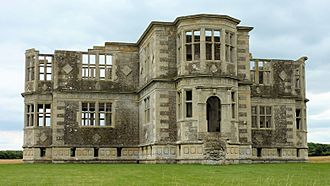Lyveden New Bield facts for kids
Quick facts for kids Lyveden New Bield |
|
|---|---|

Lyveden New Bield
|
|
| General information | |
| Type | unfinished country house |
| Architectural style | Elizabethan |
| Location | 4 miles west of Oundle |
| Country | England |
| Coordinates | 52°27′25″N 0°33′12″W / 52.45694°N 0.55333°W |
| Opened | circa 1604–05 |
| Owner | National Trust |
| Technical details | |
| Material | Structure constructed from stone |
Lyveden New Bield, sometimes called New Build, is a special unfinished summer house from the Elizabethan era (the time when Queen Elizabeth I ruled). It is located in Aldwincle, England. This historic building is owned by the National Trust, a charity that protects important places. It is a Grade I listed building, which means it's considered a building of amazing historical importance.
Contents
Building Lyveden New Bield
This unique house was built for Sir Thomas Tresham, who lived at Rushton Hall. Sir Thomas was a very strong Roman Catholic. It's believed that Robert Stickells designed the building. We don't know the exact year it was started, but it was likely around 1604 or 1605, the year Sir Thomas Tresham passed away. Lyveden New Bield was part of the estate of Tresham's other home, Lyveden Manor House, also known as Lyveden Old Bield.
A Building Full of Secrets
Just like Tresham's smaller, unusual building called Rushton Triangular Lodge, Lyveden New Bield has a religious design. It's full of hidden meanings and symbols. The building is shaped like a Greek cross, which is a cross with four arms of equal length. All sides of the building are perfectly balanced and symmetrical.
The house has two main floors above a slightly raised basement. Its windows have stone bars called mullions and transoms that divide them. Each floor was planned to have three rooms, with a staircase in the south part of the cross shape. The outside of the building is decorated with friezes, which are long bands of carvings, that show religious scenes and symbols. You can find emblems and patterns, like the "IHS" symbol (a christogram for Jesus), just like at the Triangular Lodge.
What Was Lyveden New Bield For?
The house was clearly designed for people to live in, even if only for a short time. It had a large main room (a great hall) and a sitting room (a parlour) on the first floor. The basement had a kitchen and a buttery (a room for storing food and drink). There was also a bedroom on the top floor.
The "Secret House" Idea
However, Lyveden New Bield was probably not meant for someone to live in all the time. It was too close to the main manor house to be a hunting lodge. Instead, it might have been a "Secret House." In the 16th century, it was common for wealthy families to have a secret house. This was a place, usually close to the main home, where the head of the family could go for a few days with only a few servants. This allowed the main house to be thoroughly cleaned and aired out, which was very important for health back then. Other examples of these "secret houses" exist at Leconfield and Warkworth.
Lyveden New Bield was never fully completed. It looks today much as it did when the builders stopped working after Sir Thomas Tresham's death. Today, the National Trust takes care of this amazing unfinished building.
Lyveden Old Bield
Lyveden Manor House, now known as Lyveden Old Bield, was once the main house of the estate. The Tresham family owned it from around 1450. Today, not much of the original house remains. What you can see was likely built by Thomas Tresham's grandson, Lewis. Some parts of the old house were even moved! For example, the gatehouse was taken to Fermyn Woods Hall. The main staircase was moved all the way to America and is now part of the Edsel and Eleanor Ford House near Detroit. Only one wing of the original house, with its special mullioned windows, is still standing.
In 2013, the National Trust bought Lyveden Manor House. It is now open for visitors to explore. The National Trust hopes to fully restore the historic gardens around the house and open them to the public in the future.
Gardens of Lyveden
Sir Thomas Tresham also planned beautiful and large gardens between the manor house and the New Bield. For many centuries, there was little sign of these gardens. But in 2010, experts from the National Trust made an exciting discovery! They were studying old photographs taken by the Luftwaffe (the German air force) during the Second World War. In these photos, they found the remains of an Elizabethan labyrinth (a maze-like garden), a formal garden, and an orchard. Because of this discovery, the gardens were given a Grade I listing by English Heritage, recognizing their extreme importance.
The National Trust has since worked hard to rebuild Tresham's orchard. They have also restored the moat (a ditch, often filled with water) that surrounds three sides of the labyrinth.
The Tresham Family and The Gunpowder Plot
Sir Thomas Tresham died in 1605. He had faced many difficulties because of his strong religious beliefs, and his once huge fortune had become much smaller. His son, Francis Tresham, inherited the estate. However, in the very same year, Francis became involved in the famous Gunpowder Plot along with his cousins, Catesby and Wintour. This plot was a plan to blow up the Houses of Parliament.
Because of Francis's involvement, the estate quickly had a new owner: Francis's son, Lewis Tresham. Lewis's mother managed the estate until she died in 1615. After that, Lewis Tresham, who spent money unwisely, lost the rest of the family's wealth. The estate was eventually sold after his son died in 1643.

